The Role of NGOs in Natural Disaster Management: A Detailed Analysis
VerifiedAdded on 2023/04/20
|15
|3636
|338
Report
AI Summary
This report delves into the critical role of Non-Governmental Organizations (NGOs) in natural disaster management. It explores the multifaceted components of disaster management, including prevention, mitigation, capacity building, preparedness, and response, emphasizing the significance of logistics and distribution. The analysis highlights how NGOs, both local and international, contribute to disaster relief efforts by mobilizing resources, providing humanitarian aid, and supporting evacuation and rescue operations. The report examines the advantages of NGO involvement, such as local knowledge and flexible organizational structures, while also acknowledging potential challenges. It further discusses the evolution of humanitarian logistics, the role of humanitarian service providers, and the integration of logistics service providers in disaster relief, emphasizing the importance of collaboration between NGOs and LSPs during crises. The report concludes by summarizing the pros and cons of NGO coordination in natural disaster management, underscoring their vital contributions to saving lives and reducing environmental damage.
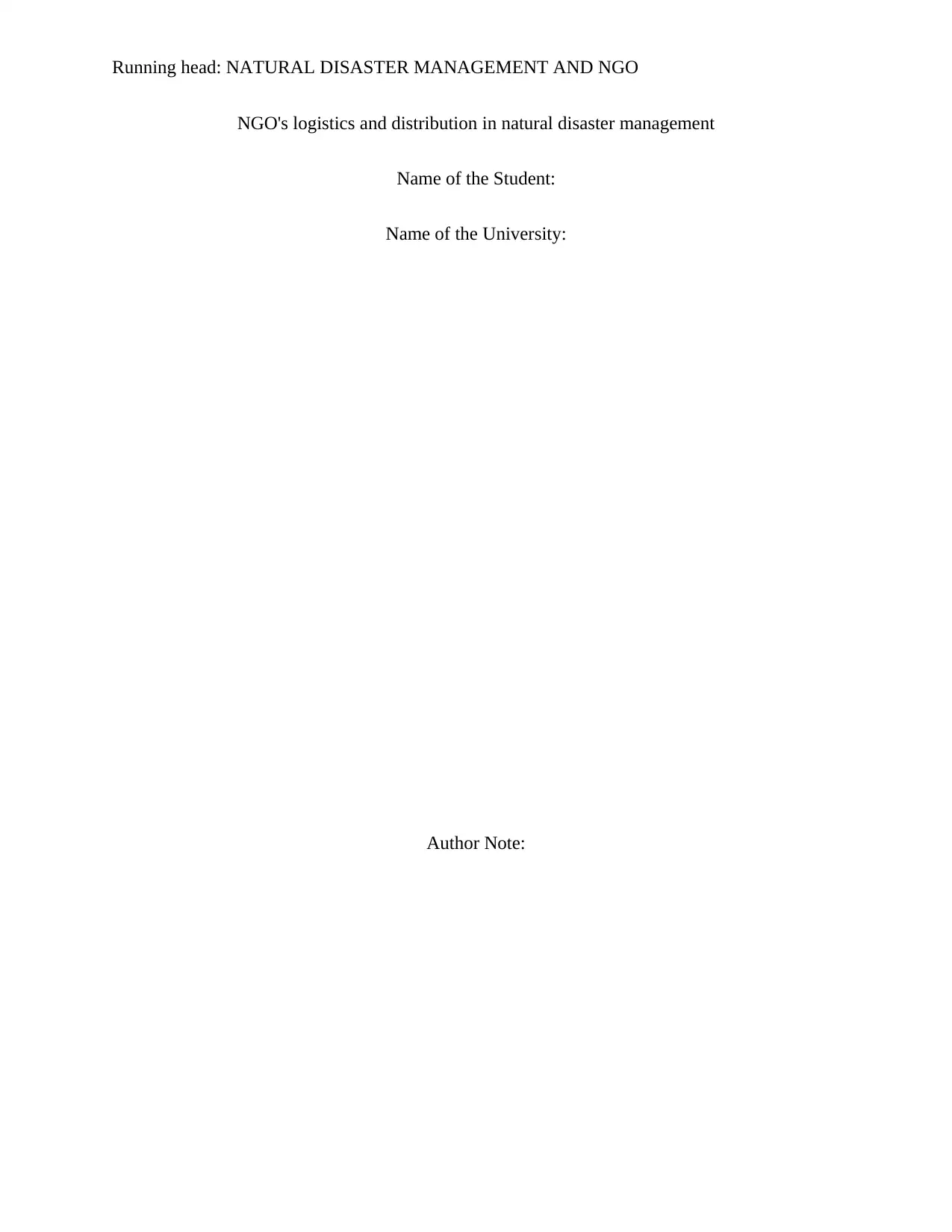
Running head: NATURAL DISASTER MANAGEMENT AND NGO
NGO's logistics and distribution in natural disaster management
Name of the Student:
Name of the University:
Author Note:
NGO's logistics and distribution in natural disaster management
Name of the Student:
Name of the University:
Author Note:
Paraphrase This Document
Need a fresh take? Get an instant paraphrase of this document with our AI Paraphraser

1NATURAL DISASTER MANAGEMENT AND NGO
Table of Contents
Introduction......................................................................................................................................2
Components of natural disaster management by NGOs and its relation with the modern world. . .2
General analysis of the role and importance of NGO's logistics and distribution in natural
disaster management........................................................................................................................5
The actualization of the natural disaster management by the NGOs...............................................6
Pros and Cons of the NGO's logistics and distribution in natural disaster management.................8
Recommendation.............................................................................................................................9
Conclusion.....................................................................................................................................10
Reference.......................................................................................................................................12
Table of Contents
Introduction......................................................................................................................................2
Components of natural disaster management by NGOs and its relation with the modern world. . .2
General analysis of the role and importance of NGO's logistics and distribution in natural
disaster management........................................................................................................................5
The actualization of the natural disaster management by the NGOs...............................................6
Pros and Cons of the NGO's logistics and distribution in natural disaster management.................8
Recommendation.............................................................................................................................9
Conclusion.....................................................................................................................................10
Reference.......................................................................................................................................12
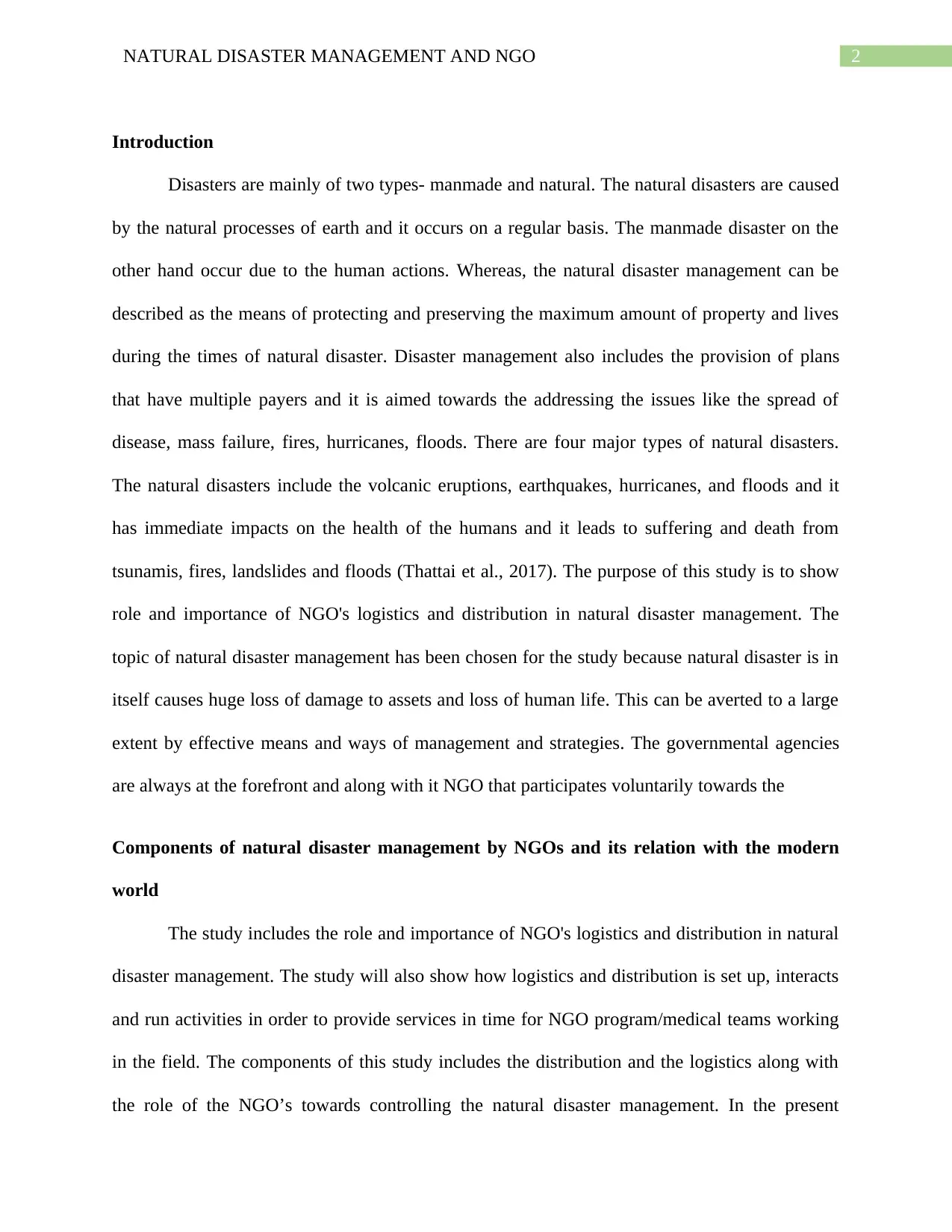
2NATURAL DISASTER MANAGEMENT AND NGO
Introduction
Disasters are mainly of two types- manmade and natural. The natural disasters are caused
by the natural processes of earth and it occurs on a regular basis. The manmade disaster on the
other hand occur due to the human actions. Whereas, the natural disaster management can be
described as the means of protecting and preserving the maximum amount of property and lives
during the times of natural disaster. Disaster management also includes the provision of plans
that have multiple payers and it is aimed towards the addressing the issues like the spread of
disease, mass failure, fires, hurricanes, floods. There are four major types of natural disasters.
The natural disasters include the volcanic eruptions, earthquakes, hurricanes, and floods and it
has immediate impacts on the health of the humans and it leads to suffering and death from
tsunamis, fires, landslides and floods (Thattai et al., 2017). The purpose of this study is to show
role and importance of NGO's logistics and distribution in natural disaster management. The
topic of natural disaster management has been chosen for the study because natural disaster is in
itself causes huge loss of damage to assets and loss of human life. This can be averted to a large
extent by effective means and ways of management and strategies. The governmental agencies
are always at the forefront and along with it NGO that participates voluntarily towards the
Components of natural disaster management by NGOs and its relation with the modern
world
The study includes the role and importance of NGO's logistics and distribution in natural
disaster management. The study will also show how logistics and distribution is set up, interacts
and run activities in order to provide services in time for NGO program/medical teams working
in the field. The components of this study includes the distribution and the logistics along with
the role of the NGO’s towards controlling the natural disaster management. In the present
Introduction
Disasters are mainly of two types- manmade and natural. The natural disasters are caused
by the natural processes of earth and it occurs on a regular basis. The manmade disaster on the
other hand occur due to the human actions. Whereas, the natural disaster management can be
described as the means of protecting and preserving the maximum amount of property and lives
during the times of natural disaster. Disaster management also includes the provision of plans
that have multiple payers and it is aimed towards the addressing the issues like the spread of
disease, mass failure, fires, hurricanes, floods. There are four major types of natural disasters.
The natural disasters include the volcanic eruptions, earthquakes, hurricanes, and floods and it
has immediate impacts on the health of the humans and it leads to suffering and death from
tsunamis, fires, landslides and floods (Thattai et al., 2017). The purpose of this study is to show
role and importance of NGO's logistics and distribution in natural disaster management. The
topic of natural disaster management has been chosen for the study because natural disaster is in
itself causes huge loss of damage to assets and loss of human life. This can be averted to a large
extent by effective means and ways of management and strategies. The governmental agencies
are always at the forefront and along with it NGO that participates voluntarily towards the
Components of natural disaster management by NGOs and its relation with the modern
world
The study includes the role and importance of NGO's logistics and distribution in natural
disaster management. The study will also show how logistics and distribution is set up, interacts
and run activities in order to provide services in time for NGO program/medical teams working
in the field. The components of this study includes the distribution and the logistics along with
the role of the NGO’s towards controlling the natural disaster management. In the present
⊘ This is a preview!⊘
Do you want full access?
Subscribe today to unlock all pages.

Trusted by 1+ million students worldwide
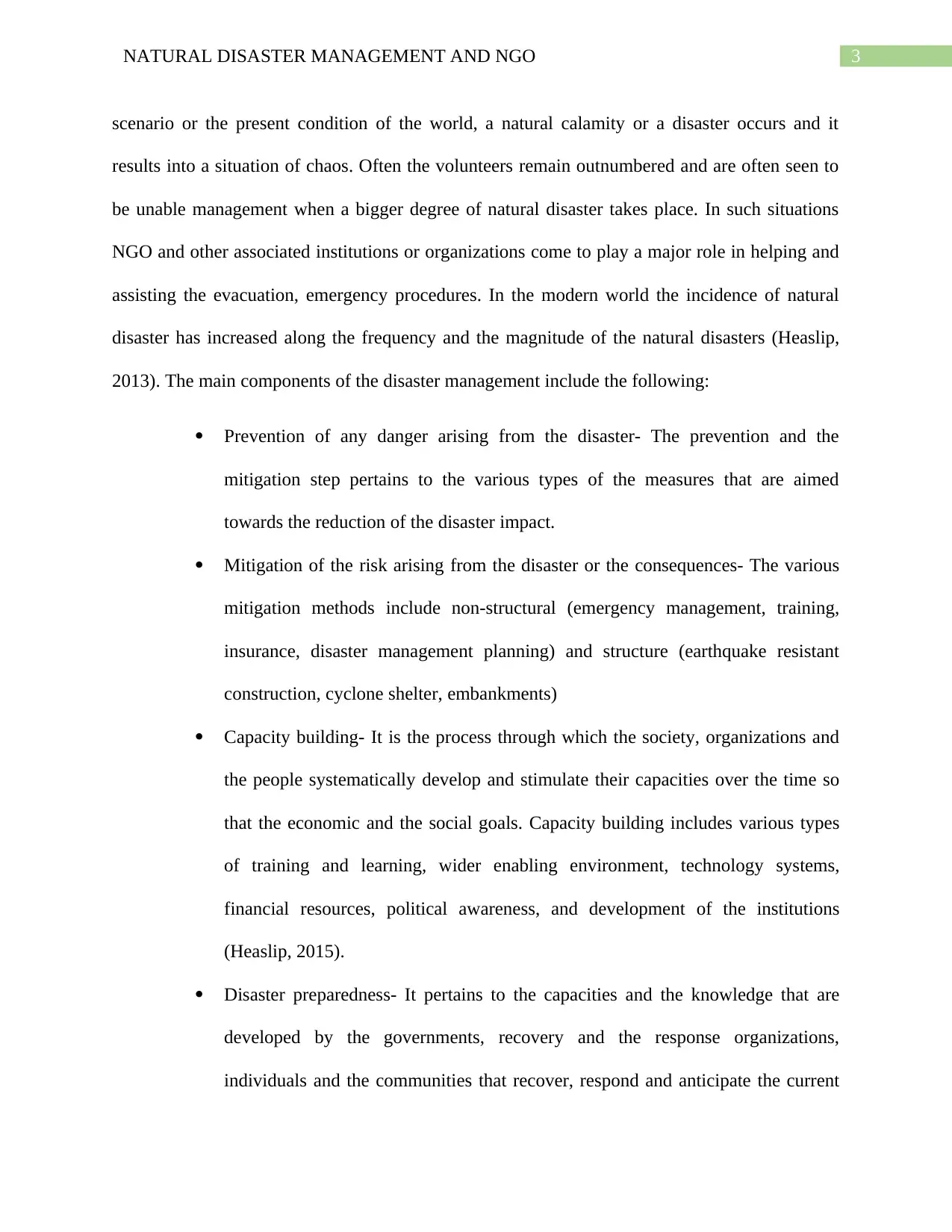
3NATURAL DISASTER MANAGEMENT AND NGO
scenario or the present condition of the world, a natural calamity or a disaster occurs and it
results into a situation of chaos. Often the volunteers remain outnumbered and are often seen to
be unable management when a bigger degree of natural disaster takes place. In such situations
NGO and other associated institutions or organizations come to play a major role in helping and
assisting the evacuation, emergency procedures. In the modern world the incidence of natural
disaster has increased along the frequency and the magnitude of the natural disasters (Heaslip,
2013). The main components of the disaster management include the following:
Prevention of any danger arising from the disaster- The prevention and the
mitigation step pertains to the various types of the measures that are aimed
towards the reduction of the disaster impact.
Mitigation of the risk arising from the disaster or the consequences- The various
mitigation methods include non-structural (emergency management, training,
insurance, disaster management planning) and structure (earthquake resistant
construction, cyclone shelter, embankments)
Capacity building- It is the process through which the society, organizations and
the people systematically develop and stimulate their capacities over the time so
that the economic and the social goals. Capacity building includes various types
of training and learning, wider enabling environment, technology systems,
financial resources, political awareness, and development of the institutions
(Heaslip, 2015).
Disaster preparedness- It pertains to the capacities and the knowledge that are
developed by the governments, recovery and the response organizations,
individuals and the communities that recover, respond and anticipate the current
scenario or the present condition of the world, a natural calamity or a disaster occurs and it
results into a situation of chaos. Often the volunteers remain outnumbered and are often seen to
be unable management when a bigger degree of natural disaster takes place. In such situations
NGO and other associated institutions or organizations come to play a major role in helping and
assisting the evacuation, emergency procedures. In the modern world the incidence of natural
disaster has increased along the frequency and the magnitude of the natural disasters (Heaslip,
2013). The main components of the disaster management include the following:
Prevention of any danger arising from the disaster- The prevention and the
mitigation step pertains to the various types of the measures that are aimed
towards the reduction of the disaster impact.
Mitigation of the risk arising from the disaster or the consequences- The various
mitigation methods include non-structural (emergency management, training,
insurance, disaster management planning) and structure (earthquake resistant
construction, cyclone shelter, embankments)
Capacity building- It is the process through which the society, organizations and
the people systematically develop and stimulate their capacities over the time so
that the economic and the social goals. Capacity building includes various types
of training and learning, wider enabling environment, technology systems,
financial resources, political awareness, and development of the institutions
(Heaslip, 2015).
Disaster preparedness- It pertains to the capacities and the knowledge that are
developed by the governments, recovery and the response organizations,
individuals and the communities that recover, respond and anticipate the current
Paraphrase This Document
Need a fresh take? Get an instant paraphrase of this document with our AI Paraphraser
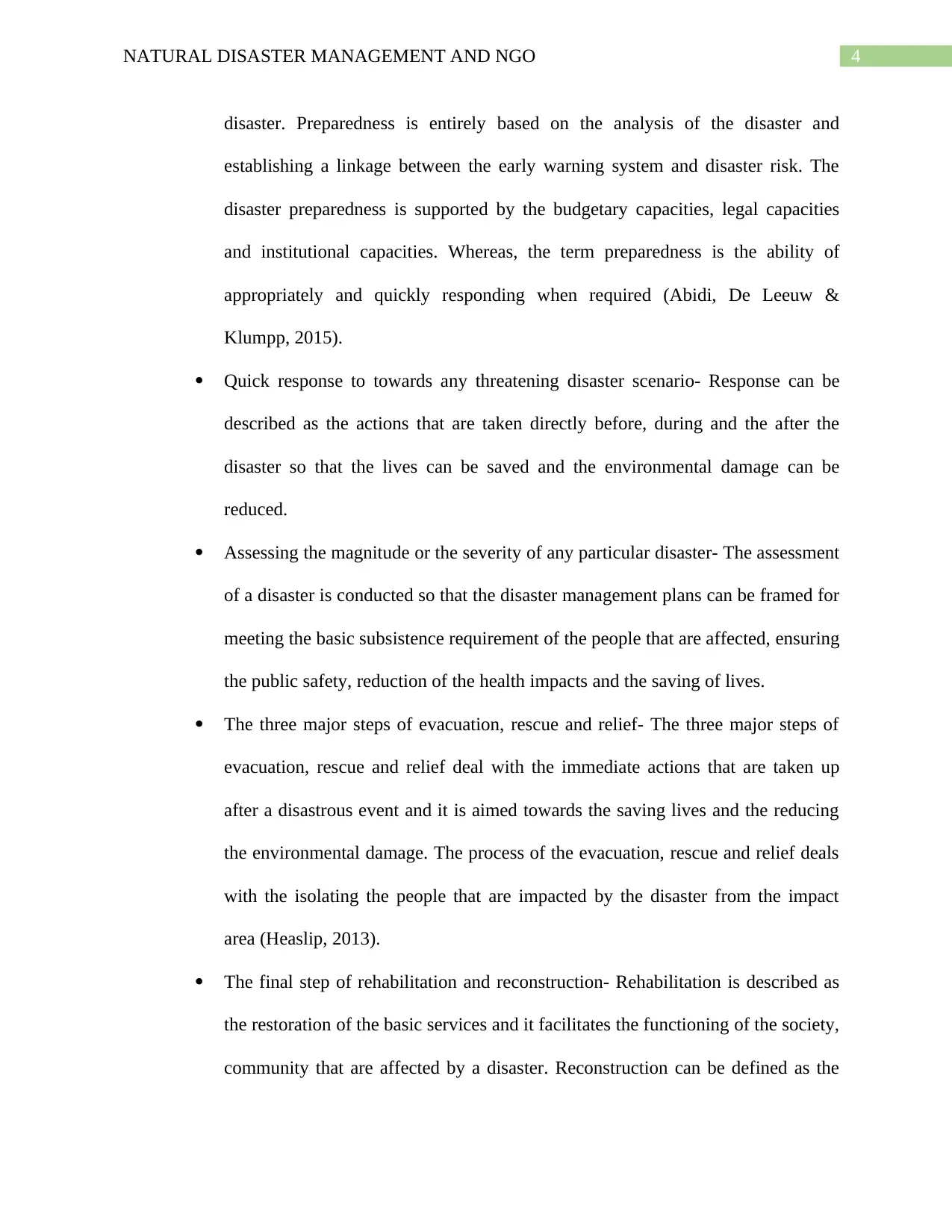
4NATURAL DISASTER MANAGEMENT AND NGO
disaster. Preparedness is entirely based on the analysis of the disaster and
establishing a linkage between the early warning system and disaster risk. The
disaster preparedness is supported by the budgetary capacities, legal capacities
and institutional capacities. Whereas, the term preparedness is the ability of
appropriately and quickly responding when required (Abidi, De Leeuw &
Klumpp, 2015).
Quick response to towards any threatening disaster scenario- Response can be
described as the actions that are taken directly before, during and the after the
disaster so that the lives can be saved and the environmental damage can be
reduced.
Assessing the magnitude or the severity of any particular disaster- The assessment
of a disaster is conducted so that the disaster management plans can be framed for
meeting the basic subsistence requirement of the people that are affected, ensuring
the public safety, reduction of the health impacts and the saving of lives.
The three major steps of evacuation, rescue and relief- The three major steps of
evacuation, rescue and relief deal with the immediate actions that are taken up
after a disastrous event and it is aimed towards the saving lives and the reducing
the environmental damage. The process of the evacuation, rescue and relief deals
with the isolating the people that are impacted by the disaster from the impact
area (Heaslip, 2013).
The final step of rehabilitation and reconstruction- Rehabilitation is described as
the restoration of the basic services and it facilitates the functioning of the society,
community that are affected by a disaster. Reconstruction can be defined as the
disaster. Preparedness is entirely based on the analysis of the disaster and
establishing a linkage between the early warning system and disaster risk. The
disaster preparedness is supported by the budgetary capacities, legal capacities
and institutional capacities. Whereas, the term preparedness is the ability of
appropriately and quickly responding when required (Abidi, De Leeuw &
Klumpp, 2015).
Quick response to towards any threatening disaster scenario- Response can be
described as the actions that are taken directly before, during and the after the
disaster so that the lives can be saved and the environmental damage can be
reduced.
Assessing the magnitude or the severity of any particular disaster- The assessment
of a disaster is conducted so that the disaster management plans can be framed for
meeting the basic subsistence requirement of the people that are affected, ensuring
the public safety, reduction of the health impacts and the saving of lives.
The three major steps of evacuation, rescue and relief- The three major steps of
evacuation, rescue and relief deal with the immediate actions that are taken up
after a disastrous event and it is aimed towards the saving lives and the reducing
the environmental damage. The process of the evacuation, rescue and relief deals
with the isolating the people that are impacted by the disaster from the impact
area (Heaslip, 2013).
The final step of rehabilitation and reconstruction- Rehabilitation is described as
the restoration of the basic services and it facilitates the functioning of the society,
community that are affected by a disaster. Reconstruction can be defined as the

5NATURAL DISASTER MANAGEMENT AND NGO
long or a medium term sustainable restoration of the critical infrastructures that
involve livelihoods, facilities, housing, services. The reconstruction process is
done to full functioning of the society or a community that are affected by the
disaster. The reconstruction process is done by aligning with the principles of the
sustainable development so that the future risks from the disaster can be reduced
(Abidi, De Leeuw & Klumpp, 2015).
General analysis of the role and importance of NGO's logistics and distribution in natural
disaster management
Non-Governmental Organizations (NGOs) can be described as a non-profit service
provider, voluntary service provider either founded by a group of individual or a single
individual. Within the purview of the civil society an NGO is characterized by independence
from the aid provided by the government, and leads to the empowering the civil society through
the advisory, humanitarian activities and assistance. In several countries the NGOs both at the
local and the international level advocate various issues related to the disaster relief,
environmental protection, development, migration, labour, human rights, anti-corruption, good
governance, democracy, poverty alleviation and community development (Vega & Roussat,
2015). Disasters occurs at the frequent intervals and the NGOs at the international and the
national level play an important role in the helping the victims affected by the disaster. After the
occurrence of a natural disaster, the NGOs work together to mobilize the various resources to
help the victims of disaster. The governmental agencies in an area work on priority basis to deal
with disaster. The local NGOs work to supplement the effort put up by the government. The
NGOs have the extensive networks and the capabilities and the NGOs work to link up the
disaster victims with the donors. The NGOs are capable of taking the evacuation plans and
long or a medium term sustainable restoration of the critical infrastructures that
involve livelihoods, facilities, housing, services. The reconstruction process is
done to full functioning of the society or a community that are affected by the
disaster. The reconstruction process is done by aligning with the principles of the
sustainable development so that the future risks from the disaster can be reduced
(Abidi, De Leeuw & Klumpp, 2015).
General analysis of the role and importance of NGO's logistics and distribution in natural
disaster management
Non-Governmental Organizations (NGOs) can be described as a non-profit service
provider, voluntary service provider either founded by a group of individual or a single
individual. Within the purview of the civil society an NGO is characterized by independence
from the aid provided by the government, and leads to the empowering the civil society through
the advisory, humanitarian activities and assistance. In several countries the NGOs both at the
local and the international level advocate various issues related to the disaster relief,
environmental protection, development, migration, labour, human rights, anti-corruption, good
governance, democracy, poverty alleviation and community development (Vega & Roussat,
2015). Disasters occurs at the frequent intervals and the NGOs at the international and the
national level play an important role in the helping the victims affected by the disaster. After the
occurrence of a natural disaster, the NGOs work together to mobilize the various resources to
help the victims of disaster. The governmental agencies in an area work on priority basis to deal
with disaster. The local NGOs work to supplement the effort put up by the government. The
NGOs have the extensive networks and the capabilities and the NGOs work to link up the
disaster victims with the donors. The NGOs are capable of taking the evacuation plans and
⊘ This is a preview!⊘
Do you want full access?
Subscribe today to unlock all pages.

Trusted by 1+ million students worldwide

6NATURAL DISASTER MANAGEMENT AND NGO
assisting the affected people with the humanitarian operations. Furthermore, the NGOs have the
informal organizational culture and the flexible organizational structure. While it is important to
mention that NGOs are capable of carrying out the humanitarian operations effectively in
comparison to the governmental agencies. The NGOs have both the expertise and the local
knowledge and thus have the advantage in conducting the disaster relief projects and the disaster
mitigation projects to meet the requirements and needs of the disaster victims (Sheppard et al.,
2013).
The actualization of the natural disaster management by the NGOs
The involvement of the local NGOs into the disaster response activities proved to be
beneficial for a large number of reasons. It is important to mention that the local NGOs functions
at the grassroots level along with the local partners that act as partners and this allows the NGOs
to respond to the disaster victims quickly. Furthermore, it is important to note that the NGOs that
are located locally are free from any kind free from any kind of bureaucratic systems and
bureaucratic structures and have the operational flexibility. The NGOs thus have the capability to
adapt quickly and respond fast (L'Hermitte et al., 2016). The NGOs that are present locally also
work along with and on behalf of the poorest and the neediest and also the most vulnerable
sections of the society. On the other hand, the NGOs also adhere to the core values pertaining to
the long term perspective, independence, impartiality, neutrality. Furthermore, it is important to
mention that the local NGOs in comparison to the big NGOs like the Amnesty International,
Oxfam international and Care international and the UN agencies have less experience in terms of
management and the supply chain of the humanitarian responses during the disaster responses
(Vaillancourt, 2016).
assisting the affected people with the humanitarian operations. Furthermore, the NGOs have the
informal organizational culture and the flexible organizational structure. While it is important to
mention that NGOs are capable of carrying out the humanitarian operations effectively in
comparison to the governmental agencies. The NGOs have both the expertise and the local
knowledge and thus have the advantage in conducting the disaster relief projects and the disaster
mitigation projects to meet the requirements and needs of the disaster victims (Sheppard et al.,
2013).
The actualization of the natural disaster management by the NGOs
The involvement of the local NGOs into the disaster response activities proved to be
beneficial for a large number of reasons. It is important to mention that the local NGOs functions
at the grassroots level along with the local partners that act as partners and this allows the NGOs
to respond to the disaster victims quickly. Furthermore, it is important to note that the NGOs that
are located locally are free from any kind free from any kind of bureaucratic systems and
bureaucratic structures and have the operational flexibility. The NGOs thus have the capability to
adapt quickly and respond fast (L'Hermitte et al., 2016). The NGOs that are present locally also
work along with and on behalf of the poorest and the neediest and also the most vulnerable
sections of the society. On the other hand, the NGOs also adhere to the core values pertaining to
the long term perspective, independence, impartiality, neutrality. Furthermore, it is important to
mention that the local NGOs in comparison to the big NGOs like the Amnesty International,
Oxfam international and Care international and the UN agencies have less experience in terms of
management and the supply chain of the humanitarian responses during the disaster responses
(Vaillancourt, 2016).
Paraphrase This Document
Need a fresh take? Get an instant paraphrase of this document with our AI Paraphraser
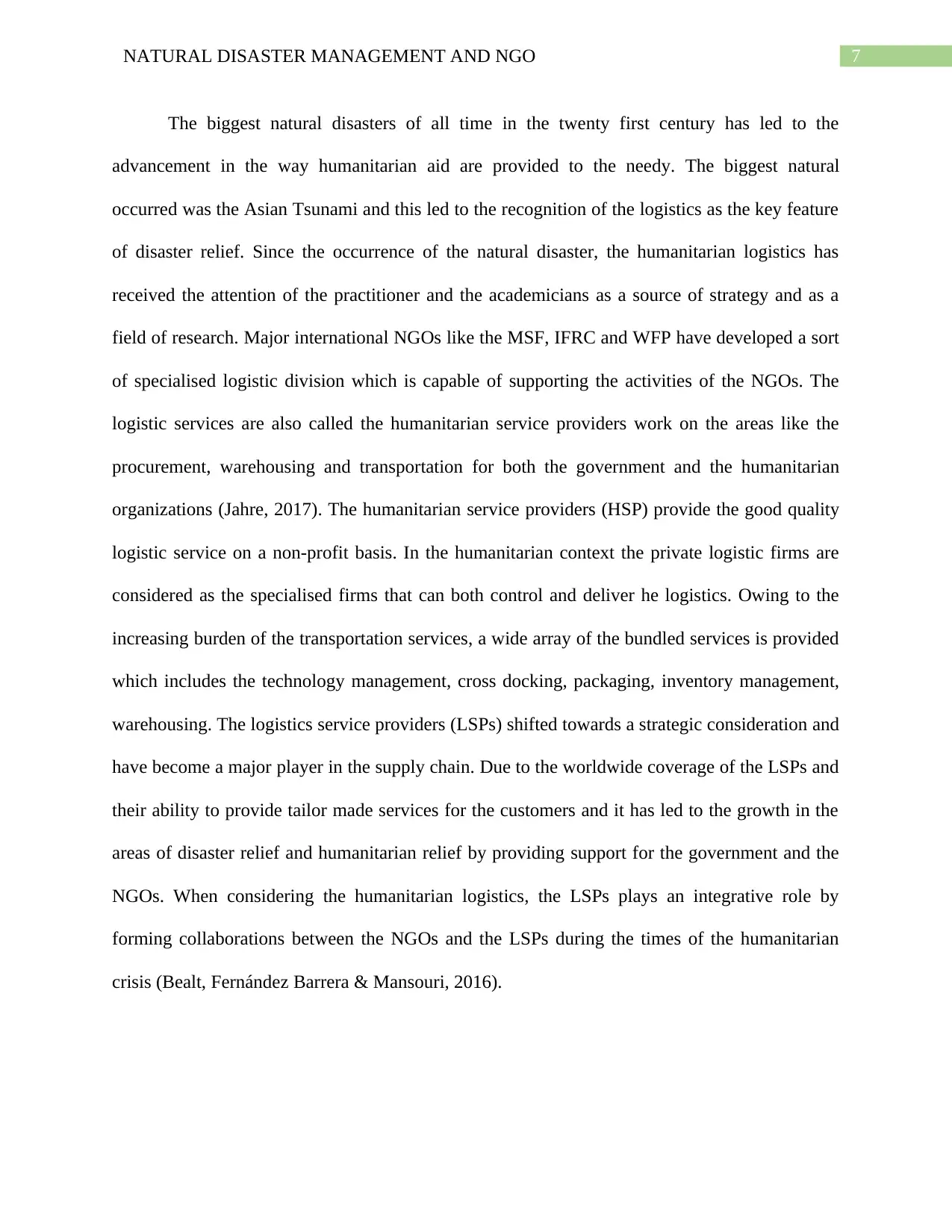
7NATURAL DISASTER MANAGEMENT AND NGO
The biggest natural disasters of all time in the twenty first century has led to the
advancement in the way humanitarian aid are provided to the needy. The biggest natural
occurred was the Asian Tsunami and this led to the recognition of the logistics as the key feature
of disaster relief. Since the occurrence of the natural disaster, the humanitarian logistics has
received the attention of the practitioner and the academicians as a source of strategy and as a
field of research. Major international NGOs like the MSF, IFRC and WFP have developed a sort
of specialised logistic division which is capable of supporting the activities of the NGOs. The
logistic services are also called the humanitarian service providers work on the areas like the
procurement, warehousing and transportation for both the government and the humanitarian
organizations (Jahre, 2017). The humanitarian service providers (HSP) provide the good quality
logistic service on a non-profit basis. In the humanitarian context the private logistic firms are
considered as the specialised firms that can both control and deliver he logistics. Owing to the
increasing burden of the transportation services, a wide array of the bundled services is provided
which includes the technology management, cross docking, packaging, inventory management,
warehousing. The logistics service providers (LSPs) shifted towards a strategic consideration and
have become a major player in the supply chain. Due to the worldwide coverage of the LSPs and
their ability to provide tailor made services for the customers and it has led to the growth in the
areas of disaster relief and humanitarian relief by providing support for the government and the
NGOs. When considering the humanitarian logistics, the LSPs plays an integrative role by
forming collaborations between the NGOs and the LSPs during the times of the humanitarian
crisis (Bealt, Fernández Barrera & Mansouri, 2016).
The biggest natural disasters of all time in the twenty first century has led to the
advancement in the way humanitarian aid are provided to the needy. The biggest natural
occurred was the Asian Tsunami and this led to the recognition of the logistics as the key feature
of disaster relief. Since the occurrence of the natural disaster, the humanitarian logistics has
received the attention of the practitioner and the academicians as a source of strategy and as a
field of research. Major international NGOs like the MSF, IFRC and WFP have developed a sort
of specialised logistic division which is capable of supporting the activities of the NGOs. The
logistic services are also called the humanitarian service providers work on the areas like the
procurement, warehousing and transportation for both the government and the humanitarian
organizations (Jahre, 2017). The humanitarian service providers (HSP) provide the good quality
logistic service on a non-profit basis. In the humanitarian context the private logistic firms are
considered as the specialised firms that can both control and deliver he logistics. Owing to the
increasing burden of the transportation services, a wide array of the bundled services is provided
which includes the technology management, cross docking, packaging, inventory management,
warehousing. The logistics service providers (LSPs) shifted towards a strategic consideration and
have become a major player in the supply chain. Due to the worldwide coverage of the LSPs and
their ability to provide tailor made services for the customers and it has led to the growth in the
areas of disaster relief and humanitarian relief by providing support for the government and the
NGOs. When considering the humanitarian logistics, the LSPs plays an integrative role by
forming collaborations between the NGOs and the LSPs during the times of the humanitarian
crisis (Bealt, Fernández Barrera & Mansouri, 2016).
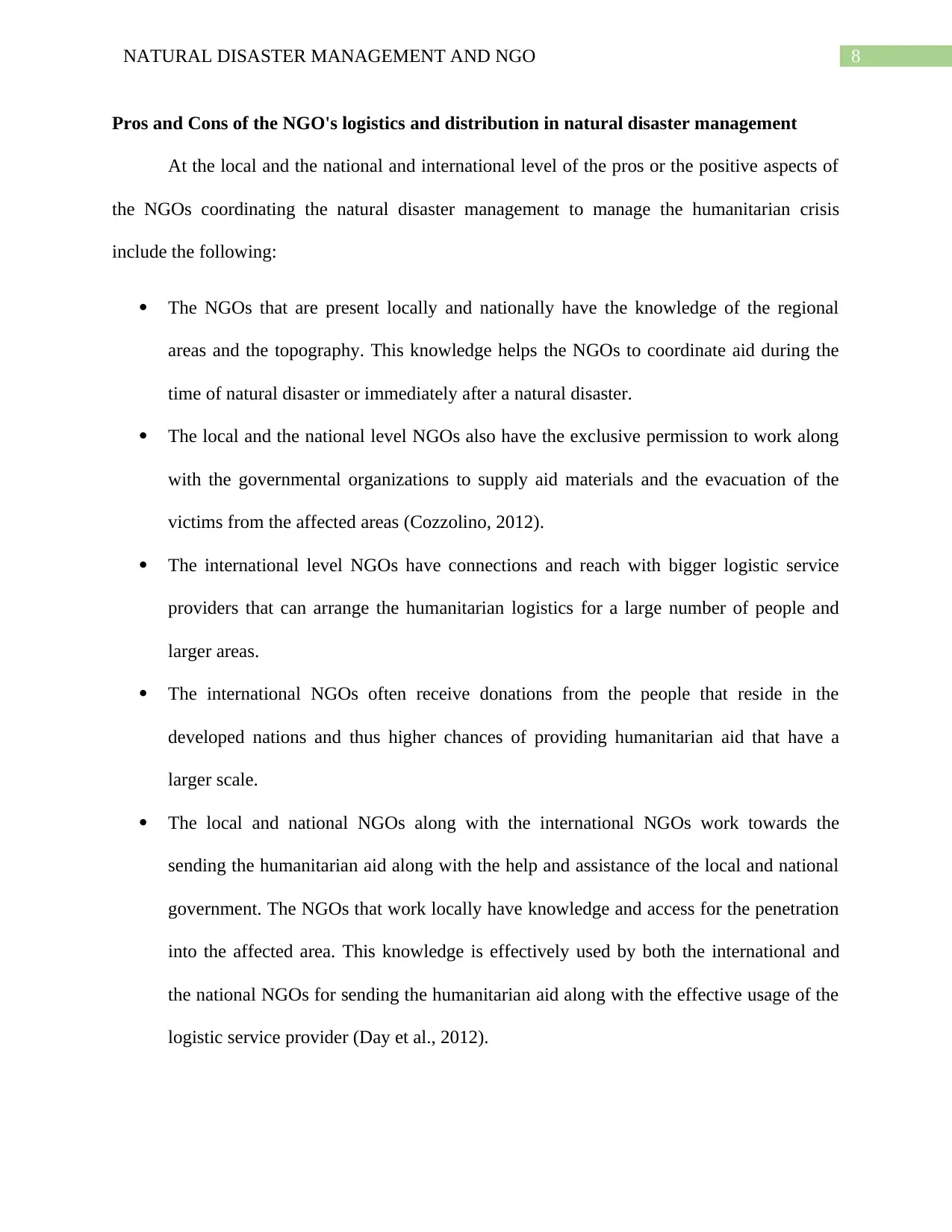
8NATURAL DISASTER MANAGEMENT AND NGO
Pros and Cons of the NGO's logistics and distribution in natural disaster management
At the local and the national and international level of the pros or the positive aspects of
the NGOs coordinating the natural disaster management to manage the humanitarian crisis
include the following:
The NGOs that are present locally and nationally have the knowledge of the regional
areas and the topography. This knowledge helps the NGOs to coordinate aid during the
time of natural disaster or immediately after a natural disaster.
The local and the national level NGOs also have the exclusive permission to work along
with the governmental organizations to supply aid materials and the evacuation of the
victims from the affected areas (Cozzolino, 2012).
The international level NGOs have connections and reach with bigger logistic service
providers that can arrange the humanitarian logistics for a large number of people and
larger areas.
The international NGOs often receive donations from the people that reside in the
developed nations and thus higher chances of providing humanitarian aid that have a
larger scale.
The local and national NGOs along with the international NGOs work towards the
sending the humanitarian aid along with the help and assistance of the local and national
government. The NGOs that work locally have knowledge and access for the penetration
into the affected area. This knowledge is effectively used by both the international and
the national NGOs for sending the humanitarian aid along with the effective usage of the
logistic service provider (Day et al., 2012).
Pros and Cons of the NGO's logistics and distribution in natural disaster management
At the local and the national and international level of the pros or the positive aspects of
the NGOs coordinating the natural disaster management to manage the humanitarian crisis
include the following:
The NGOs that are present locally and nationally have the knowledge of the regional
areas and the topography. This knowledge helps the NGOs to coordinate aid during the
time of natural disaster or immediately after a natural disaster.
The local and the national level NGOs also have the exclusive permission to work along
with the governmental organizations to supply aid materials and the evacuation of the
victims from the affected areas (Cozzolino, 2012).
The international level NGOs have connections and reach with bigger logistic service
providers that can arrange the humanitarian logistics for a large number of people and
larger areas.
The international NGOs often receive donations from the people that reside in the
developed nations and thus higher chances of providing humanitarian aid that have a
larger scale.
The local and national NGOs along with the international NGOs work towards the
sending the humanitarian aid along with the help and assistance of the local and national
government. The NGOs that work locally have knowledge and access for the penetration
into the affected area. This knowledge is effectively used by both the international and
the national NGOs for sending the humanitarian aid along with the effective usage of the
logistic service provider (Day et al., 2012).
⊘ This is a preview!⊘
Do you want full access?
Subscribe today to unlock all pages.

Trusted by 1+ million students worldwide
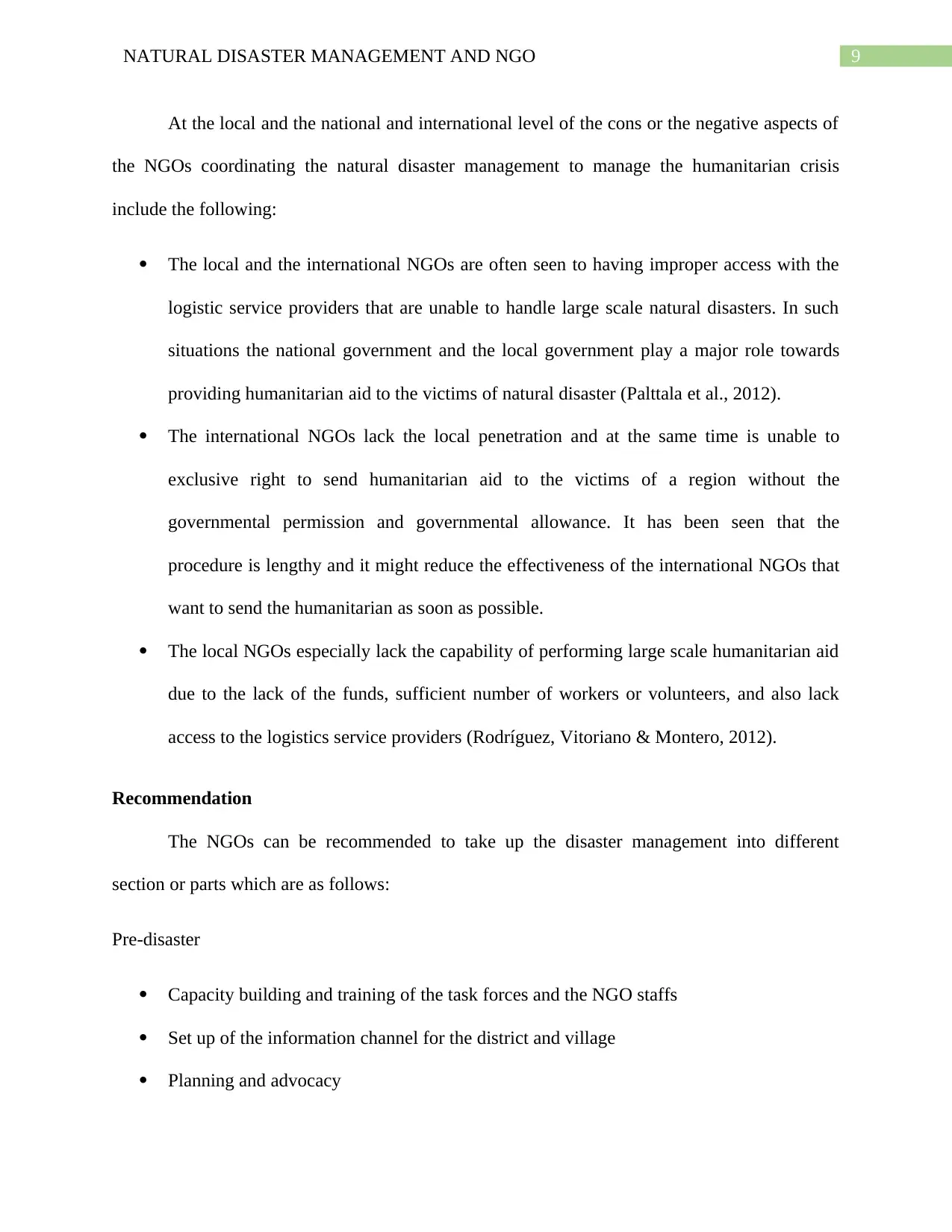
9NATURAL DISASTER MANAGEMENT AND NGO
At the local and the national and international level of the cons or the negative aspects of
the NGOs coordinating the natural disaster management to manage the humanitarian crisis
include the following:
The local and the international NGOs are often seen to having improper access with the
logistic service providers that are unable to handle large scale natural disasters. In such
situations the national government and the local government play a major role towards
providing humanitarian aid to the victims of natural disaster (Palttala et al., 2012).
The international NGOs lack the local penetration and at the same time is unable to
exclusive right to send humanitarian aid to the victims of a region without the
governmental permission and governmental allowance. It has been seen that the
procedure is lengthy and it might reduce the effectiveness of the international NGOs that
want to send the humanitarian as soon as possible.
The local NGOs especially lack the capability of performing large scale humanitarian aid
due to the lack of the funds, sufficient number of workers or volunteers, and also lack
access to the logistics service providers (Rodríguez, Vitoriano & Montero, 2012).
Recommendation
The NGOs can be recommended to take up the disaster management into different
section or parts which are as follows:
Pre-disaster
Capacity building and training of the task forces and the NGO staffs
Set up of the information channel for the district and village
Planning and advocacy
At the local and the national and international level of the cons or the negative aspects of
the NGOs coordinating the natural disaster management to manage the humanitarian crisis
include the following:
The local and the international NGOs are often seen to having improper access with the
logistic service providers that are unable to handle large scale natural disasters. In such
situations the national government and the local government play a major role towards
providing humanitarian aid to the victims of natural disaster (Palttala et al., 2012).
The international NGOs lack the local penetration and at the same time is unable to
exclusive right to send humanitarian aid to the victims of a region without the
governmental permission and governmental allowance. It has been seen that the
procedure is lengthy and it might reduce the effectiveness of the international NGOs that
want to send the humanitarian as soon as possible.
The local NGOs especially lack the capability of performing large scale humanitarian aid
due to the lack of the funds, sufficient number of workers or volunteers, and also lack
access to the logistics service providers (Rodríguez, Vitoriano & Montero, 2012).
Recommendation
The NGOs can be recommended to take up the disaster management into different
section or parts which are as follows:
Pre-disaster
Capacity building and training of the task forces and the NGO staffs
Set up of the information channel for the district and village
Planning and advocacy
Paraphrase This Document
Need a fresh take? Get an instant paraphrase of this document with our AI Paraphraser

10NATURAL DISASTER MANAGEMENT AND NGO
Regular contact with the control room of the block (Palttala et al., 2012)
During disaster
Damage assessment
Ensuring hygiene and sanitation
Immediate first aid and rescue, it includes immediate material needs, medicines, water,
supply of food, psychological aid.
Helping the block administration for the purpose of wider dissemination of warning
Activation of the channel that will disseminate the warning to reach the specific target
groups (Pelling, 2012).
Post-disaster
Monitoring
Seeking assistance for the financial aid
Material and technical aid in reconstruction (Palttala et al., 2012).
Conclusion
From the above discussion it can be concluded that, disaster management includes the
provision of plans that have multiple payers and it is aimed towards the addressing the issues like
the spread of disease, mass failure, fires, hurricanes, floods. There are four major types of natural
disasters. The natural disasters include the volcanic eruptions, earthquakes, hurricanes, and
floods and it has immediate impacts on the health of the humans and it leads to suffering and
death from tsunamis, fires, landslides and floods. Disasters occurs at the frequent intervals and
the NGOs at the international and the national level play an important role in the helping the
victims affected by the disaster. After the occurrence of a natural disaster, the NGOs work
Regular contact with the control room of the block (Palttala et al., 2012)
During disaster
Damage assessment
Ensuring hygiene and sanitation
Immediate first aid and rescue, it includes immediate material needs, medicines, water,
supply of food, psychological aid.
Helping the block administration for the purpose of wider dissemination of warning
Activation of the channel that will disseminate the warning to reach the specific target
groups (Pelling, 2012).
Post-disaster
Monitoring
Seeking assistance for the financial aid
Material and technical aid in reconstruction (Palttala et al., 2012).
Conclusion
From the above discussion it can be concluded that, disaster management includes the
provision of plans that have multiple payers and it is aimed towards the addressing the issues like
the spread of disease, mass failure, fires, hurricanes, floods. There are four major types of natural
disasters. The natural disasters include the volcanic eruptions, earthquakes, hurricanes, and
floods and it has immediate impacts on the health of the humans and it leads to suffering and
death from tsunamis, fires, landslides and floods. Disasters occurs at the frequent intervals and
the NGOs at the international and the national level play an important role in the helping the
victims affected by the disaster. After the occurrence of a natural disaster, the NGOs work
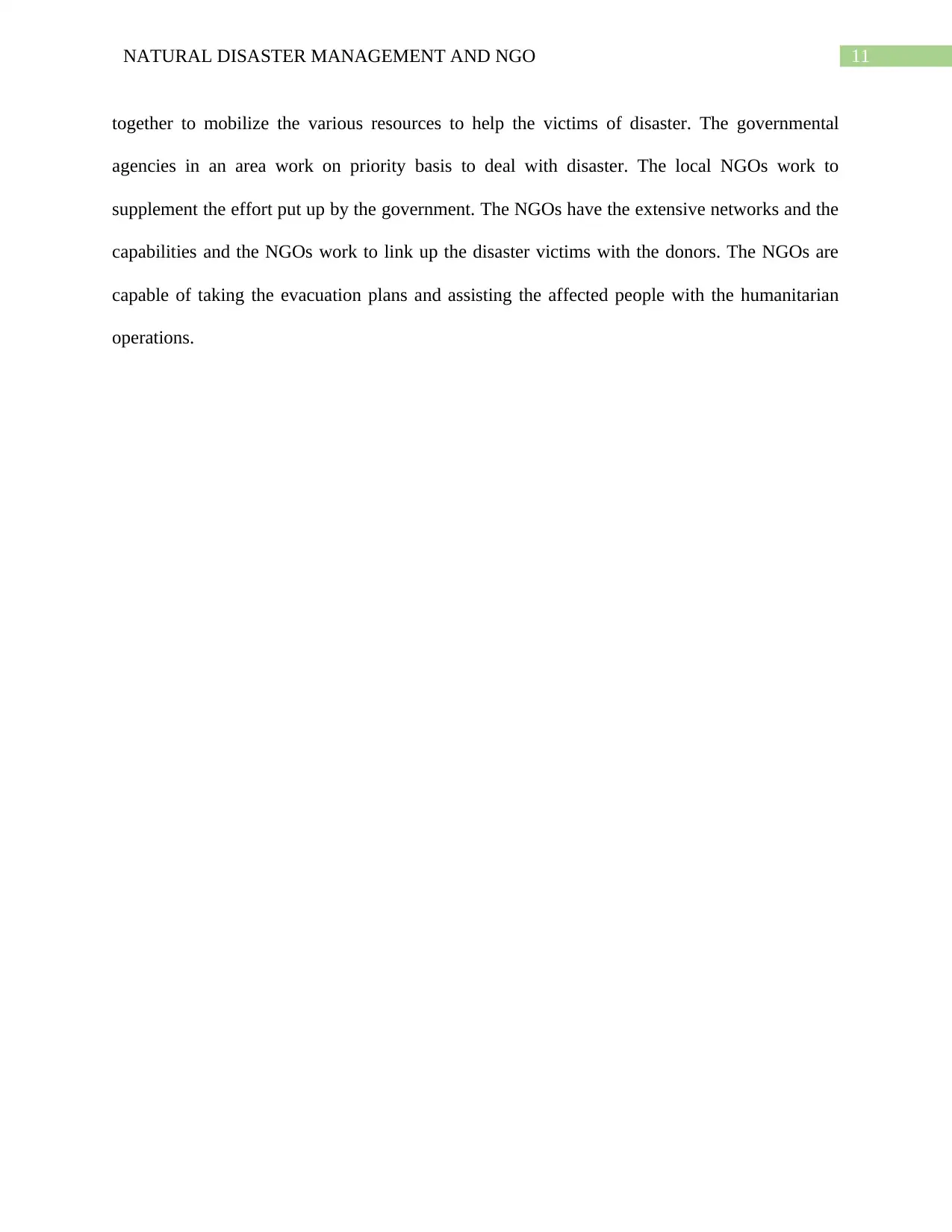
11NATURAL DISASTER MANAGEMENT AND NGO
together to mobilize the various resources to help the victims of disaster. The governmental
agencies in an area work on priority basis to deal with disaster. The local NGOs work to
supplement the effort put up by the government. The NGOs have the extensive networks and the
capabilities and the NGOs work to link up the disaster victims with the donors. The NGOs are
capable of taking the evacuation plans and assisting the affected people with the humanitarian
operations.
together to mobilize the various resources to help the victims of disaster. The governmental
agencies in an area work on priority basis to deal with disaster. The local NGOs work to
supplement the effort put up by the government. The NGOs have the extensive networks and the
capabilities and the NGOs work to link up the disaster victims with the donors. The NGOs are
capable of taking the evacuation plans and assisting the affected people with the humanitarian
operations.
⊘ This is a preview!⊘
Do you want full access?
Subscribe today to unlock all pages.

Trusted by 1+ million students worldwide
1 out of 15
Related Documents
Your All-in-One AI-Powered Toolkit for Academic Success.
+13062052269
info@desklib.com
Available 24*7 on WhatsApp / Email
![[object Object]](/_next/static/media/star-bottom.7253800d.svg)
Unlock your academic potential
Copyright © 2020–2026 A2Z Services. All Rights Reserved. Developed and managed by ZUCOL.





